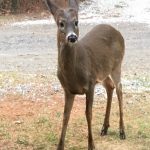This page is dedicated to sharing popular information with our website audience. Enjoy!
Deer Repelling
The white tail deer population in our region is booming. This is evident by deer presence in both rural AND residential areas.
As we encroach upon their habitat, it is up to the deer to learn to adapt. Much of the landscaping that surrounds our home is edible to deer, and in some cases, irresistible. It should be said, specifically during the summer months, not all plant browsing can be blamed on deer. Deer have no upper incisors, so the plants violated by deer will have a jagged edge to the eaten leaves or torn stems. If it is a clean cut, the damage is from another invader, such as a rabbit or woodchuck.
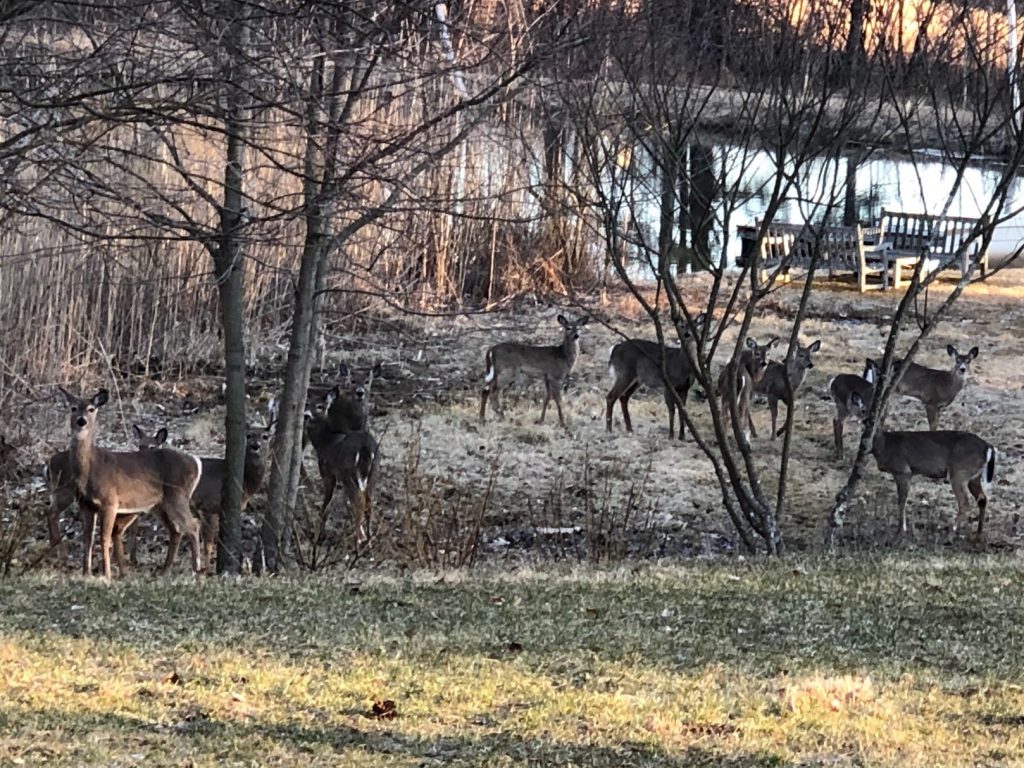
Deer herd looking for browse
The nutritional needs of deer change seasonally, and deer feed most actively in early spring and early fall. Forbs and grasses remain their primary source of nutrition, but cultivated crops can also be a target. During the harsh reality of winter, deer often will consume plants they wouldn’t otherwise consider, as they struggle to survive through the harshest season. During this season, specifically February and March, it is common to see evergreens stripped of their green from the ground to as far high as a deer can reach (browse line). This is usually an indicator that they have exhausted their browse, along with other food sources (acorns and grass buried beneath the snow), and are now forced to eat least desirable items due to hunger and starvation.
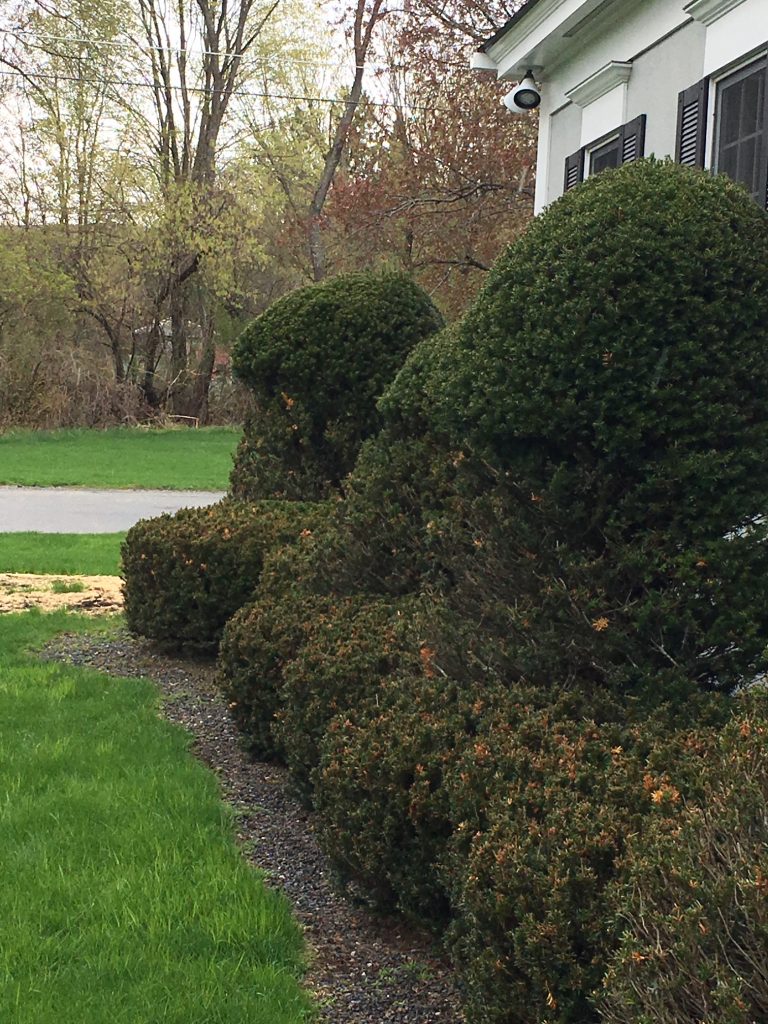
Browse line
There are many approaches to protecting your landscape investment…by being proactive versus reactive.
It makes the most sense, when starting with a fresh landscape project, to plant ONLY deer resistant plants. This will significantly reduce the chance of deer damage, and protect your financial and labor investment.
Plants deer avoid are often those those that have a strong aroma, fuzzy/prickly texture, or a bitter alkaloid taste; and they always avoid poisonous plants. However, when confronted by starvation, deer will revisit plants that may not have appealed to them in the past, except for the toxic varieties. If you choose toxic plantings to discourage deer, you must consider the danger of these plants to your family members and pets.
The factors contributing to the plant’s toxicity levels could be one or all of the following:
- Part of the plant ingested (bulbs, roots, leaves and branches, seeds or fruit)
- Growth stage (immature, new growth versus mature plant)
- Dry versus fresh (green)
Is it your dream to have a spring full of flowering bulbs? Get rid of the tulips (or the deer will do this for you), and replace with an army of daffodils!
Do you want a privacy hedge? Don’t waste your money on Yew, only to see it marred with a browse line. Plant Boxwood!
Deer Resistant Plants…
Deciduous Trees:
*Denotes that plant may be susceptible for food during harsh winters with high deep populations approaching starvation.
**Denotes that these plants have proven particularly resistant.
Beech (Fagus)*
Birch (Betula)*
Black locust (Robinia pseudoacacia)*
Maple (most Acer)*
Oak (most Quercus)*
Thornless honeylocust (Gleditsia triacanthos var. inermis)*
Evergreen Trees:
California incense cedar (Calocedrus decurrens)*
Spruce (most Picea)
Western and Oriental arborvitae (Thuja plicata and T. orientalis)*
Deciduous and Evergreen Shrubs:
Bayberry (Myrica pennsylvanica)*
Beautybush (Kolkwitzia amabilis)
Boxwood (Buxus)
Bush cinquefoil (Potentilla fruticosa)
Japanese and mountain pieris (Pieris japonica and P. floribunda)
Lilac (most Syringa)*
Magnolia (most Magnolia)*
Pfitzer juniper (Juniperus pfitzeriana)
Red buckeye (Aesculus pavia)*
Spirea (many Spiraea)
Summersweet (Clethra alnifolia)*
Viburnum (many Viburnum and their cultivars)
Perennials
Aaron’s beard (Hypericum calycinum)**
Alum root (Heuchera)
Anemone (Anemone)**
Astilbe (Astilbe)
Avens (Geum)
Baby’s breath (Gypsophila paniculata, G. repens)
Bee balm (Monarda)**
Bergenia (Bergenia)**
Big-root geranium (Geranium macrorrhizum)** mildly TOXIC
Blanketflower (Gaillardia aristata, G. x grandiflora)**
Blazing star (Liatris)**
Bleeding heart (Dicentra)** TOXIC
Bloodroot (Sanguinaria canadensis)** TOXIC
Blue star (Amsonia tabernaemontana)**
Bugbane (Cimicifuga)
Bugleweed (Ajuga reptans)**
Buttercup (Ranunculus )** TOXIC
Butterfly weed (Asclepias tuberosa) TOXIC
Campanula (C. Carpatica, C. rotundifolia)
Catmint (Nepeta)**
Celandine poppy (Stylophorum diphyllum)** TOXIC
Chrysanthemum (Chrysanthemum) TOXIC
Cinquefoil (Potentilla)**
Columbine (Aquilegia)** TOXIC
Comfrey (Symphytum)** TOXIC
Common globeflower (Trollius europaeus)** mildly TOXIC
Common tansy (Tanacetum vulgare)** TOXIC
Coneflower (Rudbeckia) moderately TOXIC
Culver’s root (Veronicastrum virginicum)**
Dame’s rocket (Hesperis matronalis)
Dead nettle (Lamium)**
English lavender (Lavandula angustifolia)** TOXIC
Evening primrose (Oenothera)
False indigo (Baptisia)
Fennel (Foeniculum vulgare)
Ferns ** some species are TOXIC
Field scabious (Knautia macedonia)
Fleabane (Erigeron) mildly TOXIC
Foamflower (Tiarella)**
Foxglove (Digitalis) TOXIC
Foxtail lily (Eremurus)**
Gas plant (Dictamnus albus)**
Germander (Teucrium canadense, T. chamaedrys)**
Globe thistle (Echinops)**
Goatsbeard (Aruncus)
Gold bleeding heart (Corydalis lutea)**
Golden groundsel (Ligularia)**
Goldenrod (Solidago)
Goldenseal (Hydrastis canadensis) TOXIC
Hellebore (Helleborus)** TOXIC
Hens-and-chicks (Sempervivum tectorum)**
Hepatica (Hepatica)** TOXIC
Hollyhock (Alcea rosea)**
Hollyhock mallow (Malva alcea)
Horehound (Marrubium vulgare)**
Horned poppy (Glaucium flavum) TOXIC
Inula (Inula)**
Iris (Iris germanica, I. cristata, I. sibirica, I. ensata, I. pseudocorus, I. tectorum) TOXIC
Irish moss (Sagina subulata)
Ironweed (Vernonia noveboracensis)**
Jack-in-the-pulpit (Arisaema)** TOXIC
Jacob’s ladder (Polemonium caeruleum)
Jerusalem sage (Phlomis)**
Joe-pye weed (Eupatorium)**
Jupiter’s beard (Centranthus ruber)**
Knapweed (Centaurea) TOXIC
Labrador violet (Viola labradorica)**
Ladybells (Adenophora lilifolia)**
Lamb’s ear (Stachys byzantina, S. officinalis)**
Lavender cotton (Santolina chamaecyparissus)**
Leadwort (Ceratostigma plumbaginoides) TOXIC
Lemon balm (Melissa officinalis)**
Leopard’s bane (Doronicum) TOXIC
Lily-of-the-valley (Convallaria majalis)** TOXIC
Lilyturf (Liriope spicata)**
Lobelia (Lobelia) TOXIC
Lungwort (Pulmonaria)** TOXIC
Lupine (Lupinus and hybrids) TOXIC
Madwort (Alyssum)** TOXIC
Meadow rue (Thalictrum)
Meadow sage (Salvia nemorosa)
Milkweed (Asclepias)** TOXIC
Miniature hollyhock (Sidalcea malviflora)
Mint (Mentha)**
Monkshood (Aconitum)** TOXIC
Mountain mint (Pycnanthemum)**
Mugwort (Artemisia)** TOXIC
Mullein (Verbascum) TOXIC
Oregano (Origanum vulgare)
Oriental poppy (Papaver orientale) TOXIC
Ornamental rhubarb (Rheum)** TOXIC
Ox-eye daisy (Telekia speciosa)**
Pachysandra (P. procumbens, P. terminalis) TOXIC
Partridgeberry (Mitchella repens)**
Peony (Paeonia)** TOXIC
Perennial blue flax (Linum perenne)** TOXIC
Periwinkle (Vinca minor) TOXIC
Phlox (P. divaricata, P. stolonifera, P. subulata)**
Pussytoes (Antennaria)** TOXIC
Queen-of-the-prairie (Filipendula)
Rodgerflower (Rodgersia)**
Rose mallow (Hibiscus) TOXIC
Rosinweed (Silphium)**
Rue (Ruta graveolens)** TOXIC
Russian sage (Perovskia atriplicifolia)** TOXIC
Sage (Salvia)**
Sea thrift (Armeria maritima)** TOXIC
Shooting star (Dodecatheon meadia)**
Soapwort (Saponaria) TOXIC
Speedwell (Veronica austriaca, V. spicata)**
Spiderwort (Tradescantia virginiana)**
Spurge (Euphorbia)**
Stonecrop (Sedum kamtschaticum, S. spurium)
Sunflower (Helianthus)
Sweet woodruff (Galium odoratum)** mildy TOXIC
Thyme (Thymus)**
Toadflax (Linaria) TOXIC
Virginia bluebell (Mertensia virginica)**
White gaura (Gaura lindheimeri)
Wild ginger (Asarum) TOXIC
Wintergreen (Gaultheria procumbens)**
Yarrow (Achillea)** TOXIC
Yellow waxbell (Kirengeshoma palmata)
Bulbs & Corms
Arum (Arum italicum)
Colchicum (Colchicum autumnale)
Daffodil (Narcissus) TOXIC
Dalmatian crocus (Crocus tomassinianus)
Ornamental onion (Allium)
Snowdrop (Galanthus nivalis)
There are several ways to protect your landscape plantings, when you decide to use plants that may be targets for deer. Here are a few options:
Deer Defeat® is an application that can be used to protect your plantings all year round. Not only does it act as a deterrent, it also has an anti-desiccation property which is essential for evergreens through the dry winter months. This application is offered as a service through Countryside Landscape & Design Inc.
Deer Stopper® is another deterrent option. It is formulated with the essential oils of Rosemary and Mint that targets the deer’s sensory response, causing the deer to avoid browsing where it has been applied. It has a mint smell, so is not offensive to humans. This application is offered as a service through Countryside Landscape & Design Inc.
Heavily scented soaps that have tallow as a component (animal-origin fatty acids) work to discourage deer. Avoid soaps with edible oils as the main ingredient. Soap will last longer if left in its wrapper and will still be noticed by deer, with their acute sense of smell. Another method, is taking soap out of its wrapper and hanging in an old nylon stocking which is then hung 3-6′ high. The scent will be more intense. Spacing is about 3′ for optimum efficiency.
Cayenne Pepper Mix: 1 gallon water + 4-5 tablespoons cayenne pepper + 1 tablespoon vegetable oil. Transfer mixture into a spray bottle, shake and apply to foliage. Reapply as needed.
Tabasco Sauce Mix: 1 gallon water + 2 tablespoons Tabasco sauce + 1 tablespoon liquid dish soap. Transfer mixture into a spray bottle, shake and apply to foliage. Reapply as needed.
Rotten Egg Mixture: (do not use on plants meant for consumption) In 2 cups of water, add 4 garlic cloves, 2 eggs, and 2 tbsp of Tabasco. Blend in a mixer and allow to rest in a covered container several days prior to application.
Install a barrier, such as deer fencing. Countryside Landscape & Design offers a few options for deer-proofing with fencing.
Wrapped deer netting: wraps around your shrubbery giving it some protection, although deer have been known to push on it to get to the edible parts that can poke through.
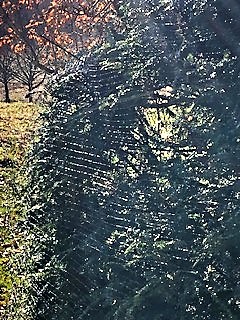
Wrapped deer netting
Black poly netting mounted on 7′ metal stakes: provides a buffer of space between the shrub and the deer are not able to access the planting by pushing on it. These mesh-like fencing options virtually blend into your landscaping.
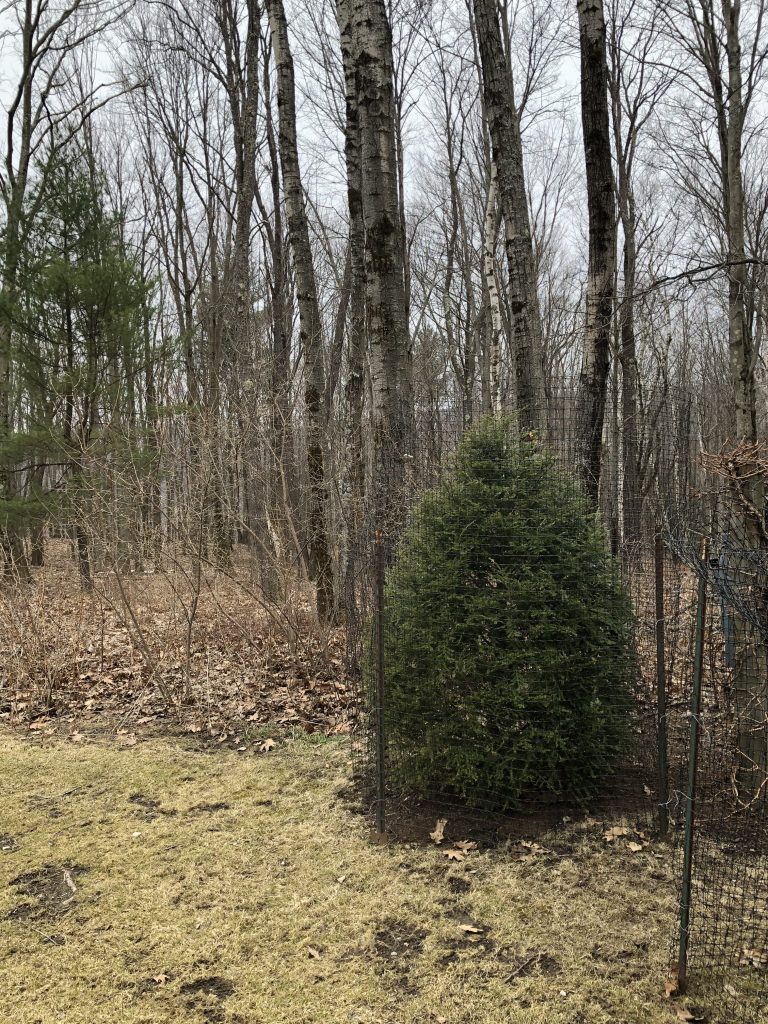
Staked black poly netting
Burlap: is an option for smaller shrubbery (burlap comes in 4′ or 6′ widths), and will also protect broad-leaf evergreens from windburn, but will not blend into the landscape. The other negative with burlap is that it will hold snow and can potentially crush what it is protecting, while the mesh options allow snow to pass through.
When your goal is to deter deer, you are best served if you employ several tactics, and rotate/alternate these tactics throughout the season. Deer are afraid of new things, so utilizing this rotation does not allow them to adapt.
Attracting Deer…
If you are one who enjoys seeing nature in your back yard, there are many ways to offer habitat to these beautiful creatures. Many states prohibit or discourage actively feeding or baiting deer, and for good reason, as it can cause them harm or even death when consuming foods they are not acclimated to.

Deer on wood’s edge
The best way to encourage deer to visit you, is to recreate their habitat. Start by planting a deer garden, or food plot, and choose plants that deer seek out, such as red clover, chicory and/or orchard grass. Along the perimeter of your deer garden is a good location for apple and oak trees. The apples and acorns provide another very desirable and natural food source for deer populations. If your property is surrounded by forest, softening the transition from the forested area to your lawn area, by allowing grasses to grow tall along the wood-line. This provides a sense of security for deer.
Resources: Deerproofing Your Yard & Garden, author: Rhonda Massingham Hart
Habitat/Stewardship gardening
This type of gardening is to create a habitat structured to support the native wildlife, by providing food and shelter that is free of pesticides and herbicides, and offers native plant species. Pollinator Friendly Gardens are becoming more common and are a wonderful way to support your pollinators by providing food and shelter for butterflies, honeybees, hummingbirds, and the lesser known pollinators that all play an important role in our planet’s ecosystem.
A Note on Natives. When embarking on creating your Habitat/Stewardship/Pollinator-Friendly Garden, try to choose plants that are native to your area. Native species share a long evolutionary history with their pollinators, and provide food & shelter for regional wildlife that exotics often cannot. By having natives in your garden, it will become a favorite for your visiting pollinators. Natives will also thrive in local conditions without the aid of chemicals, which should be avoided in these types of gardens. Plant diversity also plays an important role.
Below are some common native plants to our area:
Trees:
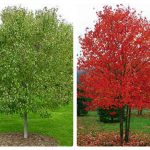
Red Maple (Acer rubrum)
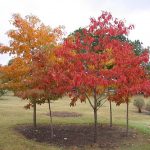
Mitten Tree (Sassafras albidum)
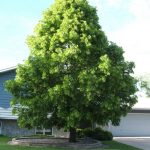
American Linden (Tilia Americana), also known as the Bee Tree
Small trees:
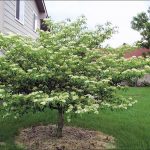
Pagoda Dogwood (Cornus alternifolia)
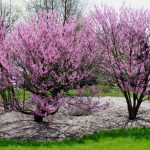
Eastern Redbud (Cercis canadensis)

Shadblow Service Berry (Amelanchier canadensis)
Shrubs:
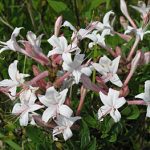
Swamp Azaliea (Rhododendron viscosum)
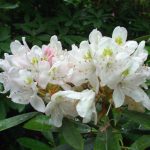
Great Rhododendron (Rhododen maximum)
Flowers:
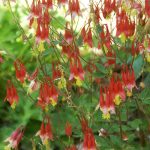
Columbine (Aquilegia canadensis)
Allegheny Foamflower (Tiarella cordifolia)
Anise hyssop (Agastache foeniculum)
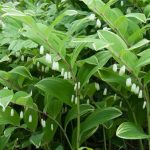
Solomon’s seal (Polygonatum)
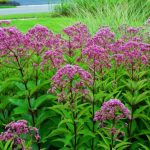
Joe-Pye Weed (Eupatorium)
Jack-in-the-Pulpit (Arisaema triphylum)
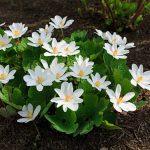
Bloodroot (Sanguinaria canadensis)
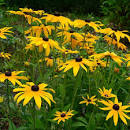
Black-eyed Susan (Rudbeckia hirta)
Native cultivars (nativars) is a cultivated variety of a native species that has been cross-bred or hybridized by plant breeders seeking desirable traits for humans. These attractive traits do not necessarily transfer to please the pollinators as many of the nativars have lost their ability to produce nectar or pollen, or are just not as favored. It is actually difficult to find true native species at local garden centers.
Another feature that is popular to have in a pollinator friendly garden are Bee Hotels. Bees can either be social or solitary, with 75% of native bees being solitary. Bee Hotels are structures for solitary bees (those that do not live in a colony or hive). By building/providing a Bee Hotel, you are providing vital habitat and a nesting site for a pollinator. Solitary bees are not aggressive, and do not pose the stinging hazard that honey bees and other aggressive hive dwellers are known for.
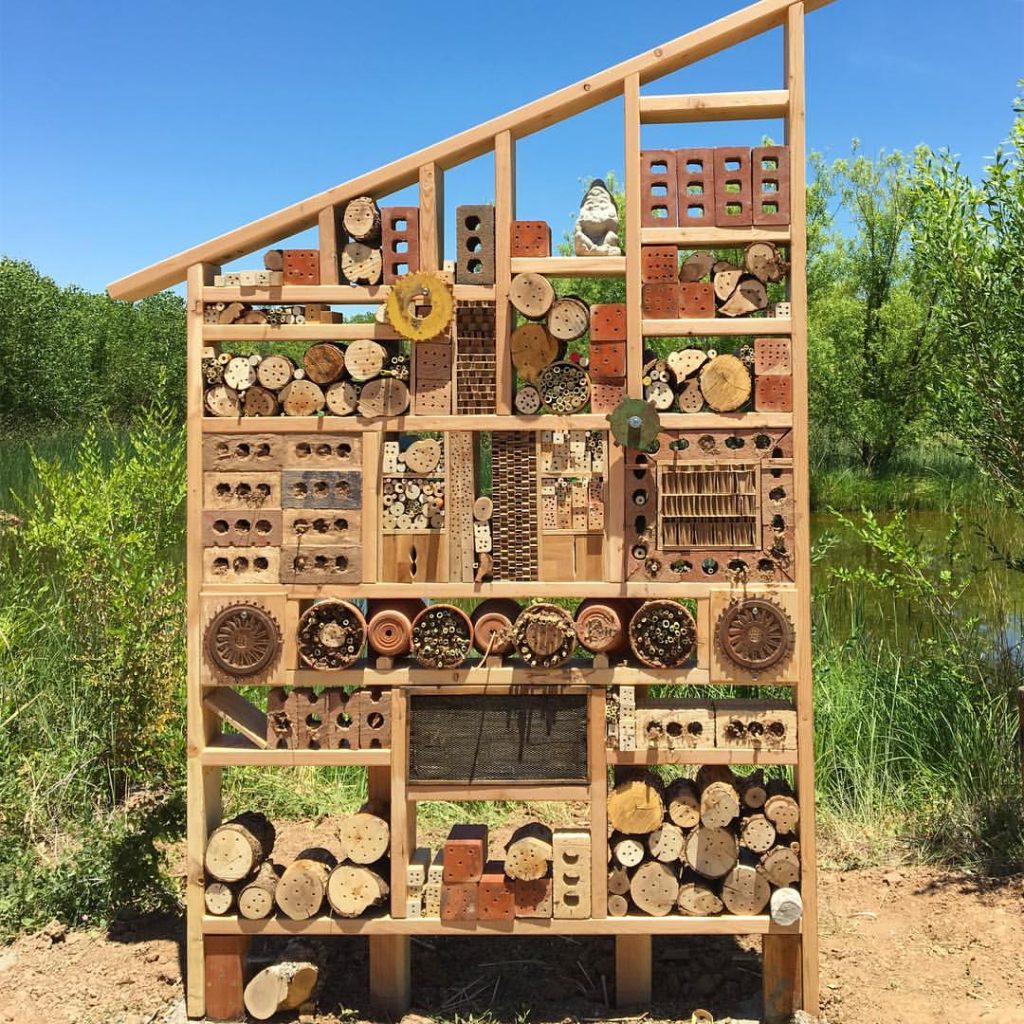
Here are some pollinator favorites:
 Goldenrod (Solidago) is a very important late season (bloom time: late summer-fall) pollinator plant. Most species are native to North America. Attracts bees and butterflies, and is deer resistant. Despite popular believe, Goldenrod does not cause hay fever; it is actually Ragweed that is responsible, which blooms at the same time.
Goldenrod (Solidago) is a very important late season (bloom time: late summer-fall) pollinator plant. Most species are native to North America. Attracts bees and butterflies, and is deer resistant. Despite popular believe, Goldenrod does not cause hay fever; it is actually Ragweed that is responsible, which blooms at the same time.
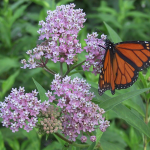
Milkweed (Asclepias syriaca) is a critically important native pollinator plant (bloom time: summer). Several dozen species of Milkweed are native to North America. Monarch caterpillars only eat Milkweed. It attracts bees, hummingbirds and butterflies, and is deer resistant.
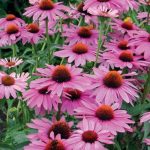
Purple Cone Flower (Echinacea purpurea) is one of the most popular native flowers (bloom time: mid-summer). Attracts bees, hummingbirds and butterflies, and is deer resistant. Leave standing over winter to provide seeds for birds.
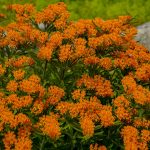
Butterfly Weed (Asclepias tuberosa) is a cousin of Milkweed, and is another native plant. Attracts bees, hummingbirds and butterflies, and is deer resistant. Bloom time is early to late summer.
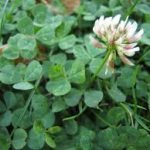 Clover (Trifolium spp.) is considered the most important pollinator plant, especially for honeybees. Bloom time is late spring to summer. Attracts bees & butterflies.
Clover (Trifolium spp.) is considered the most important pollinator plant, especially for honeybees. Bloom time is late spring to summer. Attracts bees & butterflies.
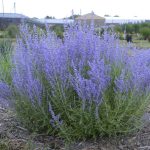
Sage (Salvias) is another favorite for pollinators, with hummingbirds being the primary pollinator. They attract bees, hummingbirds and butterflies, and is deer resistant. Bloom time is late spring to early summer.
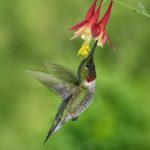
Eastern Columbine (Aquilegia canadensis) is a native woodland flower that attracts bees and hummingbirds, with hummingbirds being the primary pollinator. Bloom time is late spring to early summer, and is deer resistant.
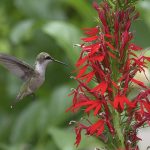
Cardinal Flower (Lobellia cardinalis) is a North American native that attracts hummingbirds and butterflies. Its bloomtime is July to September.
Plant characteristics that attract bees: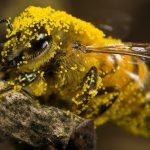
- Bright blue, white or yellow flowers that are shallow and provide a landing platform.
- Plentiful nectar, and has the presence of nectar guides (patterns/markings that aid pollinators in locating nectar).
Plant characteristics that attract butterflies:
- Brightly colored narrow/tubular flowers with nectar guides, and with landing platforms.
Plant characteristics that attract hummingbirds:
- Brightly colored funnel/tubular shaped flowers, generally in orange or red.
- Little or no scent.
- Plentiful nectar, which is 90% of a hummingbird’s diet.
Water Conservation
With climate change and the concerns of having fresh drinking water, many are rethinking how they use potable water. If you wish to practice water conservation, there are many methods you can implement to facilitate this.
- One step is to cultivate native species, as these plants are adapted to the climate and precipitation of your area. Do note, that all new plantings of natives will need watering to get them established, but once achieved, they should be content with most of what Mother Nature delivers.
- Another practice is to collect rainwater. Rain barrels can be purchased commercially, but one can be created from things you may already have, such as a water-tight plastic trash barrel, or a horse trough. Any vessel capable of holding water will work. By situating your collection receptacles beneath your down spouts, you are created a water reserve with each rainfall. This water can be used to water your plants, fill your birdbaths, or cleaning up garden tools, etc. Just remember, being in the northeast, you will have to drain these barrels to avoid freezing and breaking during winter months.
- Another tactic is mulching. Mulch has many benefits, one of them being water retention, by helping keep the plant’s roots moist.
- When you do have to water, be sure to water the soil, NOT the leaves.
- Lastly, mow ‘high’. By keeping your mow height at 4”, will allow the grass to shade the soil, and prevent excessive evaporation.
Composting
Compostable organic waste needlessly contributes to an estimated 30% of the total solid waste stream that ends up in landfills. Organic matter, especially when encapsulated in plastic garbage bags, breaks down slowly due to lack of oxygen, and will linger in the landfill, taking up unnecessary space.
By composting your food scraps and yard waste, you are not only reducing the contributions to your local landfill, but you are creating a rich organic material that can be added to your plant beds. It serves as a fertilizer, allowing you to be able to reduce/replace synthetic fertilizers, and introduces beneficial organisms to your soil.
Composting works by combining green matter (food scraps, egg shells, coffee grounds, grass clippings) with brown matter (leaves, straw, paper, branches), and water. The best combination of green to brown is to have about 30-40% green matter. Green matter provides nitrogen, brown matter provides carbon, and water provides the moisture necessary for breakdown. It is good to water your compost pile during dry spells to speed up the decomposing process.
The optimal temperature for your compost pile is 120oF. Aerobic microorganisms produce heat as a byproduct of consuming compost materials. When your pile reaches 130-140oF, this will kill most pathogens.
Avoid adding meat or dairy waste in your compost, along with dog or cat waste (poop/litter). Composting these types of waste require heat to kill pathogens, so if you don’t monitor the temperature of your pile, it is best to avoid these altogether.
Avoid adding weeds that have gone to seed, otherwise you will be spreading seeds later on, unless you are using a closed composter that gets hot enough to kill the seed.
Mulch
Generally is comprised of wood-chips, straw or bark. It is advised to stay away from colored mulch due to the dye chemical content that is added to provide color, as they may be toxic. Please BEWARE of cocoa bean mulch, which is toxic to dogs.
Mulch will help insulate and protect plant roots in both summer and winter. It aids in soil moisture conservation, prevents erosion, and acts as a barrier to soil born organisms. Mulch also suppresses weed growth. When mulch is applied, decomposition occurs mostly in the thin layer where the mulch touches the soil surface, as it decomposes, it will improve soil health.
Mulch should not be piled up against woody stems of shrubs or trees, as it can cause rot and encourage rodents. Keep deep mulch pulled back 6” – 12”.
Wood chip mulch is not ideal to use in vegetable gardens, as it makes it harder for digging. The better alternative would be grass clippings or straw. If you use hay, be sure it is weed-free.
Leaf litter can serve as a form of mulch. Leaf mulch can be used to mulch vegetable gardens, flower beds, and around trees. When leaves have fallen, allow to dry, and collect without raking by attaching mower bag. Add shredded leaves where you want them. Because they are dry, they will decompose quickly. It is important that your leave mulch is shredded as the shredding makes the mulch penetrable to air and water.
Once dry, use a lawn mower to chop leaves into bits. Because the leaves are dry, they will decompose quickly back into the soil.
Compost can also be used to mulch with, provided that the compost was produced in a way that the right bacteria is present, and the pile gets hot enough to kill most weed seed.
Avoid using Peat Moss as it is not sustainable.
When mowing your lawn, allow your grass clippings to remain. This simple action returns moisture and nutrients, which are similar to the benefits of mulch.
Countryside Landscape & Design uses mulch that is double ground hemlock, spruce and pine bark.
Cover Crops
Cover crops are not grown to be eaten, but rather to protect and enrich the soil. By planting cover crops, the physical and biological properties of soil are improved. Cover crops are considered green manures, as when they are turned over, they provide organic matter and nutrients. They both retain nitrogen and provide weed control.
Tilling soil tends to over-aerate, causing a rapid breakdown of organic matter, and releasing CO2 into the atmosphere. Most common reason to till is to add air or allow organic matter to penetrate down into soil. Yet, most plants’ feeder roots are located near the surface where air and biological activity is present. Tilling also disturbs both fungi and earthworms, which are essential for healthy soil. Earthworms actually aerate soil while breaking down organic matter. As they eat, they leave behind castings which are a valuable type of fertilizer. Fungi’s contribution is that it binds soil together, creating an aggregate that increases water holding capacity, and filtration.
Cover crops create a living mulch in gardens and aid in reducing erosion. They can also be planted in bare spots in your garden when early season produce is harvested. If left bare, the soil becomes subject to erosion and mineral depletion. By planting a cover crop in available space in your garden, you can contribute beneficial organic nutrients to that soil.
